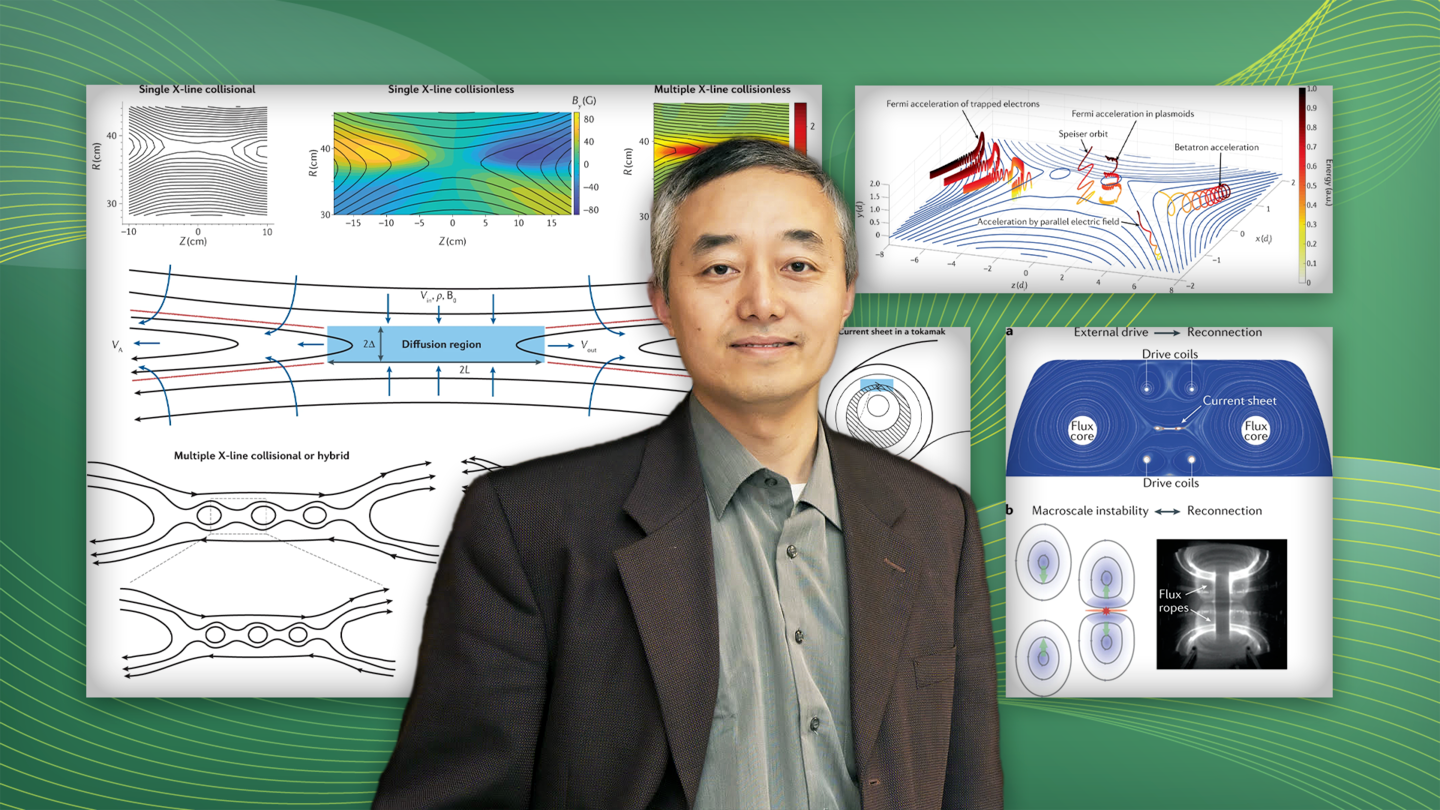Reviewed by Alex SmithApr 25 2022
Magnetic reconnection is a puzzling phenomenon that causes explosive occurrences throughout the cosmos, including solar flares and space storms, which may disrupt cell phone service and electrical power systems.
 Physicist Hantao Ji with figures from magnetic reconnection paper. Image Credit: Photo by Elle Starkman/PPPL Office of Communications; collage by Kiran Sudarsanan.
Physicist Hantao Ji with figures from magnetic reconnection paper. Image Credit: Photo by Elle Starkman/PPPL Office of Communications; collage by Kiran Sudarsanan.
Now, scientists from the Princeton Plasma Physics Laboratory (PPPL) of the US Department of Energy (DOE) have described a path for unraveling a major piece of this puzzle, which could provide new insight into the universe’s workings.
By breaking apart and explosively reconnecting magnetic field lines in astrophysical plasmas, reconnection transfers magnetic field energy to particle eruptions — a process that happens inside dissipation zones that tend to be tremendously smaller than the regions they influence.
Stressed magnetic field
Plasma does not like reconnection. However, reconnection does happen when the magnetic field is sufficiently stressed. Dissipation scales are tiny whereas astrophysical scales are very large and can extend for millions of miles. Finding a way to bridge these scales through a multiscale mechanism is a key to solving the reconnection puzzle.
Hantao Ji, Study First Author, Physicist and Professor, Princeton Plasma Physics Laboratory, Princeton University
The study was published in Nature Reviews Physics.
The roadmap outlines the importance of developing technologies with multiscale capabilities, like the Facility for Laboratory Reconnection Experiment (FLARE), a recently added collaborative facility that is being upgraded and will investigate aspects of magnetic reconnection previously unavailable to laboratory experiments. Simulations on upcoming exascale supercomputers, which will be 10 times faster than present computers, will complement these tests.
Ji added, “The hope is for FLARE and exascale computing to go hand-in-hand.”
Multiple plasmoids, or magnetic islands, that develop from reconnection along with long plasma current sheets, according to the PPPL roadmap, might cross a large variety of sizes. Multiscale laboratory experiments are intended to give the first testing of this theory and to assess alternative ideas, with such plasmoids more closely matching the impacted reconnection zone.
Exascale will allow us to do more credible simulations based on high-fidelity FLARE experiments.
Jongsoo Yoo, Study Co-Author and Physicist, Princeton Plasma Physics Laboratory, Princeton University
The new machine’s enhanced size and power — its diameter will be double that of PPPL’s long-running laboratory experiment, the Magnetic Reconnection Experiment (MRX) — will allow scientists to more closely replicate reconnection in nature.
FLARE can access wider astrophysical regimes than MRX with multiple reconnection points and measure the field geometry during reconnection. Understanding this physics is important for predicting how reconnection proceeds in solar flares.
William Daughton, Study Co-Author and Computational Scientist, Los Alamos National Laboratory
Key challenge
Inventing novel high-resolution diagnostic systems free of constraining assumptions will be a crucial task for the next trials. FLARE will be able to build on satellite sightings such as those provided by the Magnetospheric Multiscale mission, a network of four spacecraft launched in 2015 to research reconnecting in the magnetosphere, the magnetic field that reaches earth, once these systems are improved.
“Progress in understanding multiscale physics critically depends on innovation and efficient implementation of such diagnostics systems in the coming decade,” the research stated.
How does the reconnection process begin?
What are the methods for heating and accelerating explosive plasma particles?
How does reconnection affect related phenomena like turbulence and space shocks?
Yoo noted, “The paper lays out plans to provide the entire space physics and astrophysics communities with methods to solve the multiscale problem.” A breakthrough like this would be a huge step toward a deeper comprehension of magnetic reconnection in vast systems all around the cosmos.
The DOE Office of Science is funding this research (FES). Jonathan Jara-Almonte of PPPL and Ari Le and Adam Stanier of Los Alamos National Laboratory are among the co-authors.
Journal Reference:
Ji, H., et al. (2022) Magnetic reconnection in the era of exascale computing and multiscale experiments. Nature Reviews Physics. doi.org/10.1038/s42254-021-00419-x.